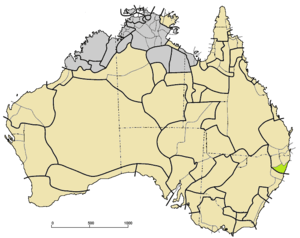Kumbainggar language
| Gumbaynggirr | |
|---|---|
| Kumbainggar | |
| Region | New South Wales, Australia |
Native speakers |
90 (2016 census)[1] (may include L2 speakers) |
|
Pama–Nyungan
| |
| Dialects |
|
| Language codes | |
| ISO 639-3 |
kgs |
| Glottolog |
kumb1268[3] |
| AIATSIS[4] |
E7 |
 | |
Gumbaynggir language (also spelled Gumbaingari, Kumbainggar, Kumbaingeri, Gambalamam, and also called Baanbay) is an Australian Aboriginal language. It is spoken by the Gumbaynggirr, who are native to the Mid North Coast of New South Wales.
It is the only surviving language in the Gumbaynggiric family of Pama–Nyungan stock.
Organised revitalisation of Gumbaynggir has been underway since 1986 when Muurrbay Aboriginal Language and Culture Co-operative was founded at Nambucca Heads.[5] Classes in Gumbaynggir are taught through the North Coast Institute of TAFE up to Certificate II level.
It has a binary way of counting numbers.
Revitalization
Muurrbay and Many Rivers Aboriginal Language Centre (MRALC) supports Aboriginal language revitalization through activities that include[6]
- Providing access to linguistic expertise, and training for Aboriginal people.
- Recording languages wherever possible, and assisting with access to archival materials, providing a regional storage base for these materials.
- Producing language materials such as dictionaries or wordlists, grammars, learner’s guides, transcriptions and translations.
- Providing community access to languages by using, and assisting communities to use information technology such as: Transcriber, Shoebox, Powerpoint and Adobe Audition.
- Employing linguists, Aboriginal language researchers and specialists in Information and Communication Technology.
- Raising awareness in the wider community about the value of Aboriginal languages.
Funding
Muurrbay Aboriginal Language and Culture Cooperative Ltd at Bellwood receives from the following government organizations:
- The Australian Government has an Indigenous Languages Support (ILS) program which gives money to community driven digital and multi-media resources as a tool for maintenance, revival and development of native languages[7]
- New South Wales Department of Aboriginal Affairs has funded the Muurrbay Center Sydney based Aboriginal Languages Summer School[8]
In November 2011, the Australian government declared an Indigenous Protected Area for the Gumbaynggirr people. The Indigenous Protected Areas act protects the native land of indigenous Australians. The protection of the land ties into the spiritual beliefs of the Gumbaynggirr people and by protecting the land, the government is helping revitalize their culture.[9]
References
- ↑ ABS. "Census 2016, Language spoken at home by Sex (SA2+)". stat.data.abs.gov.au. Australian Bureau of Statistics. Retrieved 2017-10-29.
- ↑ Dixon, Robert M. W. (2002). Australian Languages: Their Nature and Development. Cambridge University Press. p. xxxiv.
- ↑ Hammarström, Harald; Forkel, Robert; Haspelmath, Martin, eds. (2017). "Kumbainggar". Glottolog 3.0. Jena, Germany: Max Planck Institute for the Science of Human History.
- ↑ Gumbaynggirr at the Australian Indigenous Languages Database, Australian Institute of Aboriginal and Torres Strait Islander Studies
- ↑ Muurrbay Aboriginal Language and Culture Co-op. "Gumbaynggirr Language Revitalisation". Retrieved 5 August 2012.
- ↑ Muurrbay Aboriginal Language and Culture Co-op. "Gumbaynggirr Language Revitalisation". Retrieved 5 August 2012.
- ↑ "Indigenous Languages Support (ILS)".
- ↑ Muurrbay Aboriginal Language and Culture Co-op. "Certificate II in Gumbaynggirr language & culture". Retrieved 5 August 2012.
- ↑ "Gumma Indigenous Protected Area". Retrieved 5 November 2011.
External links
- Bibliography of Gumbaynggir people and language resources, at the Australian Institute of Aboriginal and Torres Strait Islander Studies
- Rosetta Project: Kumbainggar Swadesh List